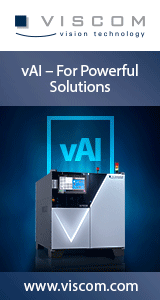|

|
|
| Ask the Experts | |||||||
|
|||||||
|
August 21, 2006 - Updated July 5, 2007 - Originally Posted Problems with solder paste stencilsWe're having problems with solder paste not releasing from the apertures on a micro BGA (11 mil balls) using type 4 mesh paste (Kester EP256). Stencil is 5 mil, SS, laser cut, electro-polished, do we need an eform stencil? How thick? Apertures reduced 5% - 10%? Jeff Thompson |
|||||||
| Expert Panel Responses | |||||||
|
Normally it is a good design guide to have the area Ratio above .66 for Laser-Cut stencils. The normal aperture sizes for micro BGA's are in the 11 to 12 mil range which gives an area Ratio of .55 and .60 respectively. AMTX Electroform stencils provide good paste transfer with area Ratios as low as .50. I have attached a copy of the Area Ratio Calculator ( Click here for the Area Ratio Calculator for Circles. Click here for the Area Ratio Calculator for Rectangles). My recommendation is to use an AMTX Electroform stencil. The vast majority of our customers with uBGA's use the AMTX Electroform stencil.
Vice President Technology Photo Stencil For over 18 years, Dr. Coleman has been the vice president of technology for Photo Stencil, working closely with customers to understand their printing requirements. His efforts have resulted in several new stencil products.
The first thing to do is calculate the area ratio of the stencil aperture. If the area ratio is below .6 the solder paste will not release from the stencil. Area ratio is the ratio between the area of the aperture opening and the area of the aperture walls. Area ratio is the most important factor in determining how well solder paste will release from a stencil. We call the percentage of solder paste that enters the aperture that releases from the aperture "Transfer Efficiency". The higher the area ratio the higher the transfer efficiency. We (Speedline Technologies) have stencil design software that we can provide at no cost to help with your stencil design calculations.
Principal Consultant ITM Consulting Mr. Belmonte has been a process engineer and process engineering manager in the electronic manufacturing industry for over 25 years, with experience in all aspects of electronic product assembly operations. He is well-known throughout Asia and SE Asia for both his process work and teaching engagements.
The rule of thumb for printing small round and small square apertures can be helpful in determining the proper stencil guidelines in this case. The Area Ratio is defined as the (Area of the opening) / (Area of the walls). This ratio should be greater than 0.66 in order to achieve the correct conditions for solder paste release from the stencil during printing. A process with an Area Ratio of <0.66 will result in poor release and inconsistent volume from pad to pad. As an example, a 12-mil square pad (and stencil aperture) with a 5-mil thick stencil would have and area of the opening of 144 sq mils (12 x 12) and an area of the walls of 240 sq mils (12 x 5 x 4). Since 144/240 = 0.6, this situation may be marginal in terms of aperture release. A larger square pad and/or a slightly thinner stencil should help with release. (Changing to a 14-mil square aperture elevates the Area Ratio to 0.7.) When the area ratio is near 0.66 (especially if just under 0.66), you may achieve some improvement by going with e-form stencils. The smoother walls should promote release when the numbers aren't in your favor. Additionally, such marginal situations require extra-special care of the stencil during the process in terms of frequent and complete cleaning to insure that extra paste is not drying in the apertures and preventing release on subsequent prints. I would not advise reducing apertures in such applications as it will only worsen any issues with paste release. Furthermore, square apertures will usually give better release than round ones. The selection of Type 4 powder is adequate but may not necessary for this application once the stencils are properly designed for the application.
General Manager - Electronic Assembly Americas DEK International Mr. Smith has been supporting customers in the electronics assembly industry since 1994. His expertise is focused on solder paste printing and reducing soldering defects. He holds a BS in Chemical Engineering and an MBA in Marketing. He has authored several papers in trade magazines and at industry conferences. He is an SMTA Certified Process Engineer.
|
|||||||
| Submit A Comment | |||||||
|
Comments are reviewed prior to posting. You must include your full name to have your comments posted. We will not post your email address. |
|
Free Newsletter Subscription
Circuitnet is built for professionals who bear the responsibility of looking ahead, imagining the future, and preparing for it. Insert Your Email Address |
|

|





